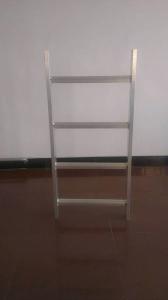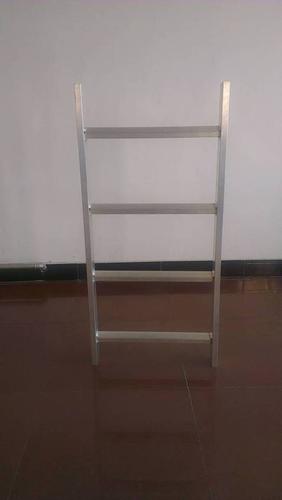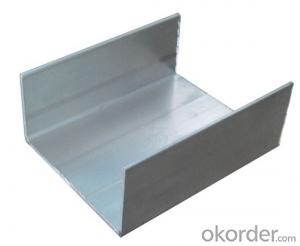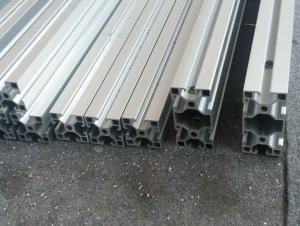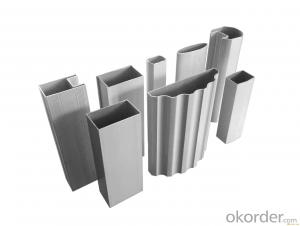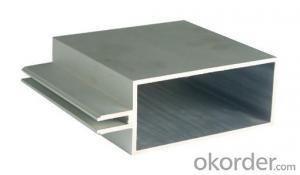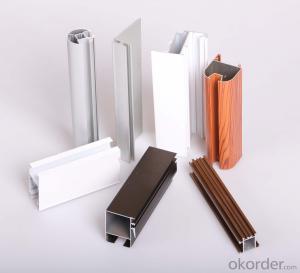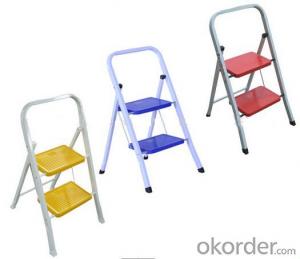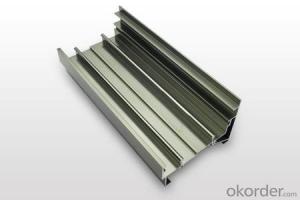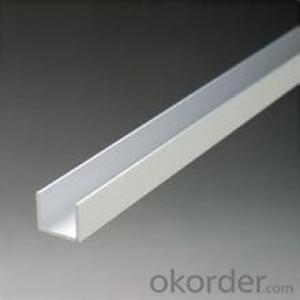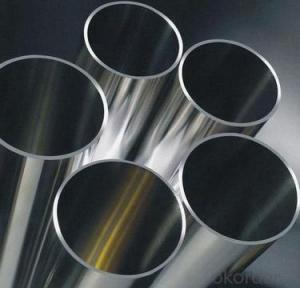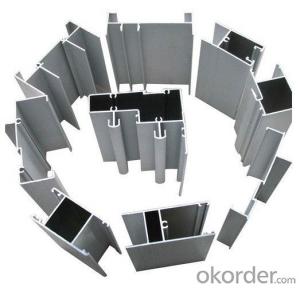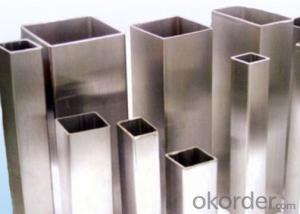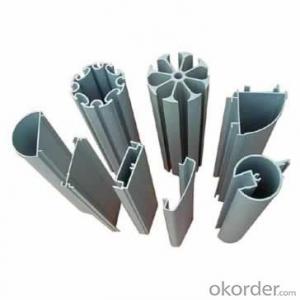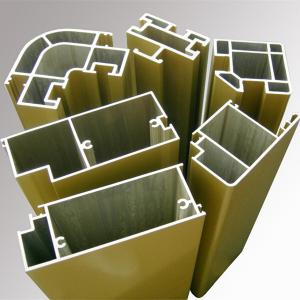Aluminum Windows Profiles Household Step Ladder
OKorder Service Pledge
OKorder Financial Service
You Might Also Like
Lightweight, easy to carry
Alloy: 5xxx and 6xxx
High quality: anticorrosion, rust protection and easy clean surface
Maximum loading capacity: 150kg
Number of steps: 4
Standard package: suitable for long ocean transporting
OEM&ODM is welcome
Last for life time
Specifications
1. Aluminium Ladder
2. Silver Matt Anodizing
3. Reasonable Price
4. Satisfied Service
5. Prompt DeliveryProduct Advantages
1. Plenty of surface treatments for your choice
2. Strict control for surface finish, very little scratch.
3. Accurate mold as well as accurate size.
4. Standard alloy composition aluminium ladder
5. Both ends of the profiles are very plain and with no burr.
- Q: What are the safety features of aluminum profiles in construction?
- Aluminum profiles are a popular choice for construction due to their range of safety features. They are both lightweight and durable, making them easy to handle and install while still providing structural integrity. This reduces the risk of accidents or injuries during the construction process. Furthermore, aluminum profiles are non-combustible, meaning they do not contribute to the spread of fire. This is crucial for ensuring the safety of occupants and minimizing fire-related hazards. In addition, aluminum profiles have excellent corrosion resistance properties. They are naturally resistant to rust and decay, allowing them to withstand harsh environmental conditions and maintain their structural integrity over time. This is particularly important in coastal or humid areas where corrosion risk is high. Moreover, aluminum profiles can be designed to incorporate safety features such as non-slip surfaces or grooves for enhanced grip and stability. This is especially beneficial in applications where slip and fall accidents may occur, such as staircases or walkways. Additionally, aluminum profiles offer excellent electrical conductivity, making them advantageous for electrical installations. Their high thermal conductivity helps dissipate heat efficiently, reducing the risk of overheating or electrical malfunctions. Lastly, aluminum profiles are recyclable, aligning with sustainable construction practices and contributing to waste reduction and environmental impact. In conclusion, the safety features of aluminum profiles in construction, including their lightweight yet durable nature, non-combustibility, corrosion resistance, ability to incorporate non-slip surfaces, excellent electrical conductivity, and recyclability, make them a safe and sustainable choice for construction projects.
- Q: What are the different finishing options available for aluminum profiles?
- There are various finishing options available for aluminum profiles to enhance their appearance and provide additional protection. These options can be broadly categorized into surface treatments and coatings. Surface treatments include anodizing, powder coating, and polishing. Anodizing is a popular technique that involves creating a durable and corrosion-resistant layer on the aluminum surface through an electrochemical process. It provides a wide range of colors and finishes while maintaining the metallic look. Powder coating involves applying a dry powder to the aluminum surface and then curing it using heat, resulting in a smooth and durable finish. Polishing is another option that involves mechanically smoothing the surface of the aluminum, giving it a reflective and glossy appearance. Coatings, on the other hand, involve the application of a protective layer on the aluminum. These coatings can be organic or inorganic. Organic coatings, such as paint or lacquer, provide a decorative finish and protect the surface from scratches and oxidation. Inorganic coatings, such as ceramic or enamel, are more durable and resistant to abrasion, heat, and chemicals. Additionally, aluminum profiles can also undergo mechanical finishing processes like brushing or sandblasting. Brushing gives the aluminum a textured finish by using abrasive brushes to create a pattern on the surface. Sandblasting involves forcibly propelling fine particles at high speed to roughen the surface, giving it a matte appearance. The choice of finishing option depends on the intended application, aesthetic preference, and the desired level of protection. Each option has its advantages and disadvantages, so it is essential to consider factors like durability, maintenance, and cost before selecting the appropriate finishing option for aluminum profiles.
- Q: Are aluminum profiles resistant to impact?
- Yes, aluminum profiles are generally resistant to impact due to their inherent strength and durability.
- Q: What are the standards and regulations that control the use of aluminum profiles in construction?
- <p>Yes, there are several standards and regulations that govern the use of aluminum profiles in construction. These include international standards such as ISO 7039 and ISO 8039, which specify requirements for aluminum alloy extruded profiles. In the United States, the American Architectural Manufacturers Association (AAMA) provides guidelines, and the Aluminum Association sets standards for aluminum products. European standards like EN 755 and EN 12206 cover aluminum extrusions for general purposes and structural applications. Compliance with these standards ensures the safety, durability, and performance of aluminum profiles in construction projects.</p>
- Q: Are aluminum profiles compatible with glass or other glazing materials?
- Glass and other glazing materials can be used with aluminum profiles. Aluminum is a popular choice for window and door frames because it is strong, durable, and versatile. Combining aluminum with glass allows for the creation of stylish and functional windows, doors, and architectural elements. Aluminum profiles are specifically designed to securely hold and support glass panels, ensuring a safe and stable glazing system. Furthermore, aluminum profiles can also be used with polycarbonate or acrylic sheets, giving flexibility in design and construction. In summary, aluminum profiles are highly compatible with glass and various glazing materials, making them a dependable option for contemporary architectural projects.
- Q: What kind of self tapping screw can attack aluminum profile?
- General aluminum, iron, stainless steel can attack ah!
- Q: Do aluminum profiles require any special maintenance?
- Aluminum profiles do not require any special maintenance. Aluminum is a durable and low-maintenance material that is resistant to corrosion, rust, and weathering. Unlike other materials such as wood or steel, aluminum profiles do not need to be regularly painted, stained, or treated to maintain their appearance or functionality. Additionally, aluminum is lightweight, making it easy to handle and install. However, it is important to keep the aluminum profiles clean by regularly removing dirt or debris with a mild detergent and water solution. This will help to preserve the aesthetic appeal and longevity of the profiles. Overall, aluminum profiles are a convenient and hassle-free option for various applications, as they do not require any special maintenance.
- Q: Is it possible to recycle aluminum profiles and use them again in construction?
- <p>Yes, aluminum profiles can be recycled and reused in building construction. Aluminum is highly recyclable, and the recycling process requires significantly less energy compared to producing new aluminum. Recycled aluminum maintains its strength and properties, making it suitable for various construction applications. This practice not only conserves resources but also reduces waste and environmental impact.</p>
- Q: This question asks for an overview of the typical materials used in the production of aluminum profiles.
- <p>Aluminum profiles are commonly made from various aluminum alloys, each with specific properties suited for different applications. The most common materials include 6063 aluminum alloy, known for its good mechanical properties and corrosion resistance, making it ideal for construction and industrial applications. 6061 aluminum alloy is also widely used due to its high strength-to-weight ratio and is often found in aerospace and automotive industries. Other alloys such as 6082 and 7075 are used for their superior strength and are common in heavy-duty applications. Each alloy is chosen based on the required strength, weight, and resistance to environmental factors for the intended use of the aluminum profile.</p>
- Q: Are aluminum profiles suitable for exhibition displays?
- Exhibition displays can benefit greatly from the use of aluminum profiles. This material is both lightweight and durable, making it perfect for constructing modular structures that can be effortlessly transported and assembled at various exhibition venues. These profiles are versatile and can be employed to build display walls, stands, booths, and other components of an exhibition. One major advantage of using aluminum profiles for exhibition displays lies in their adaptability. They can be easily modified and adjusted to meet specific design requirements, enabling the creation of unique and captivating displays. Furthermore, aluminum profiles can be easily connected and disassembled, which makes them a practical choice for exhibitions that demand frequent setup and teardown. Another benefit of utilizing aluminum profiles for exhibition displays is their visual appeal. Aluminum has a sleek and modern appearance that can enhance the overall impact of an exhibition. It can also be finished with various coatings or colors to match the branding or theme of the event, further augmenting the overall presentation. Additionally, aluminum profiles offer exceptional stability and strength, ensuring that exhibition displays can withstand the demands of a bustling exhibition environment. They are also resistant to corrosion, which is crucial when considering the longevity and durability of the display. In conclusion, aluminum profiles are a suitable option for exhibition displays due to their lightweight nature, durability, versatility, aesthetic appeal, and strength. They provide the necessary stability and can be easily customized to create visually appealing and functional exhibition displays.
Send your message to us
Aluminum Windows Profiles Household Step Ladder
OKorder Service Pledge
OKorder Financial Service
Similar products
Hot products
Hot Searches
Related keywords
